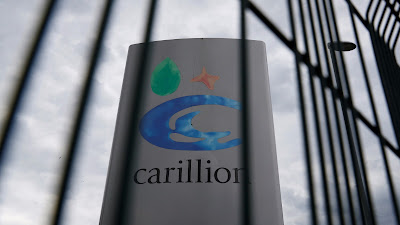Pensions Regulator Comes Under Fire over Carillion
The case of Carillion has made for a number of posts here in
Financial Regulation Matters, ranging
from the commencement
of the crisis to the fallout, both in regards to the effect
upon the sector and also the effect
upon the pension fund and the protective framework that exists to protect
pension holders from these sorts of crises. However, news that broke today
concerning the performance of the pensions regulator in the U.K. and,
specifically, its performance in the previous few years regarding the
ever-deteriorating situation at Carillion has brought the pensions regulator’s
performance to the forefront of discussions. In today’s post, we will review
this breaking news and further examine the pensions regulator as, one would
assume, the crisis continues and associated authorities are dragged further into
the mire in relation to this massive collapse.
Rather than restart the examination of Carillion in any
great detail, it is best to start with the issue at hand. Today’s news consists
of warnings that were put forward by Carillion’s (Pension-related) Trustees,
which they
must do in relation to the relevant laws contained within the Companies Act of
2006 (section 898). However, whilst it appears that the trustees performed
as they should, the news today revolves around the notion that, despite a
number of warnings to the pension regulator about underfunding, and a generally
poor attitude by company bosses when concerning properly funding the company’s
pension schemes, those warnings
were not heeded by the regulator. When the warnings were acted upon,
details today reveal that the regulator did put pressure on the company to put
resources into the pension fund, albeit below the level requested by the
trustees. The story goes that the trustees had strongly suggested to the
company that it should provide £35 million a year for the fund to be properly
maintained, with the company only then offering to pay just £25 million; after
this was branded as ‘unacceptable’
by the trustees, the trustees returned with a further warning that
contributions totalling £65 million a year over a period of 14 years were what
was needed, with the company responding by offering just £33.4 million a year
over 15 years. It was at this point that the trustees sought the intervention
of the regulator; the regulator has responded by stating that they did
intervene, and that their pressure amounted to a ‘significant increase’ in
the amount of money that the company were willing to pay into the pension pot.
However, with the trustees claiming that the actual deficit in the fund was far
larger than Carillion bosses would admit to (it
has been revealed now that the likely deficit is just short of £1 billion),
the question now revolves around the regulator’s insistence that it applied
pressure, despite the fund’s deficit increasing beyond expected levels – the
regulator is due to give evidence to Parliamentary Committees next week.
Frank Field, who
we discussed yesterday, has suggested that he is expecting, or at least
hoping, that the pension regulator performs
more diligently in the attempted clawing back of some of the money that was
paid out in bonuses to company officials, although that comment represented
more of a dig at the regulator than an instruction. With the regulator facing
questions next week, the issue here is what the future may look like for the
regulator once the dust settles from the Carillion crisis.
The regulator’s actions, in presumably applying ‘pressure’
but not taking direct action, fundamentally places the regulator within the
conversation concerning the best way to move forward in light of such massive
corporate collapses. On the one hand, the regulator does have powers to
intervene, but was happy with the reported financial situation at the company
(admittedly, backed by auditor’s reports, which raises questions about the role
of auditors). However, the obvious issue with this is what is the point of the
regulator having these powers to intervene if they are not going to use them?
In this scenario, there is clear evidence of trustees raising the red flags,
operating according to procedure and taking the issue to the regulator, and
then the regulator not acting. Whilst it is not a case of right or wrong, for
the most part, it is clear to see that the warnings put forward by the trustees
were well founded. Perhaps, this is just the latest example of the pro-business
mantra developed by regulators that has come to encapsulate the current era;
siding with the business when there is any room for manoeuvre is, apparently,
the modus operandi of financial regulators and it is vital that this stops.
There is far too much evidence to demonstrate that whilst business needs to be
allowed to operate, having a pro-business attitude when regulating financial
entities causes substantial social problems, but yet it persists. The issues
raised by white-collar crime studies, like the almost absolute absence of
prosecution in these matters, are raised time and time again, and one wonders
what the breaking point may be to tip the scales, if at all.
Keywords – Carillion, Financial regulation, pensions,
Business, Law, Crime, @finregmatters.





Comments
Post a Comment